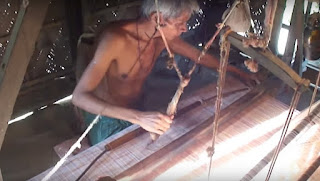The
Khadi / Khaddar of cumilla have been known as special and famous since ancient
times in the history. This weaving cloth was also exported abroad after met the
demand of the country. A professional community was involved in the weaving
industry from the beginning. Locally they were called as 'Yogi' or 'Debnath'.
During the time of Mahatma Gandhi non-cooperation movement in British India and
due to some historical reasons, Khadi industry grew rapidly and gained
popularity in the region.
That
time, Khadi / Khaddar cloth was made from cotton of Rangamati. There was many
Yogi or Debnath families living in Chandina, Devbidwar, Burichang and Cumilla Sadar
upazila of the district. When Gandhiji called for the exclusion of foreign
textiles, there was a huge response in Comilla area and the production of Khadi
cloth increased a lot. The khadi clothes of Comilla were spreading in different
parts of the country. These fabrics gained popularity as a brand called Comilla's
khadi / Khadi of Cumilla.
The
Abhay Ashram of Mahatma Gandhi in Comilla played an important role in promoting
the Khadi industry across the India sub-continent. Abhay Ashram was established
as a social welfare institute and established as a shelter ground for the
practice. When the call for the exclusion of foreign cloth began to cut in
large quantities, the yarn was produced a lot using Charka. Abhay Ashram then
sold the Charka in local Bazaar and also was making khadi cloths themselves.
Khadi cloth that was made in different villages started to be marketed through
Abhay Ashram.
History
says, an eight hand tall dhoti was sold for only five paisa in the period of 1926-27.
At that time, Comilla Abhay Ashram sold khadi clothes more than worth about Taka
9 lac. According to the writings of late Rabindra Sangeet singer, an activist
of Abhay Ashram, Parimal Dutt said that even though there was huge demand which
was not completely fulfilled from the supply of Abhay Ashram.
Due
to the rapid demand for khadi, holes were drilled in the ground beneath the
foot-driven paddle of taat boutique machine. The cloth that originates from
this hole or alloy was called Khadi. Thus the origin of the name became Khadi.
Gradually this cloth gained fame in the name of Khadi or Khaddar.
The
golden age of the Khadi industry was after the 1971 independence. Soon there
was a crisis. Huge numbers of war-torn taat garments were closed. In order to
meet the demand for textiles, there was a lot of pressure on handmade weaving
cloth in such an import depended country. Although the production of khadi was
not widespread in comparison to the needs of the people of the country. Weavers
in the villages around the center of Chandina started making mattresses,
curtains and cloths etc.
Before
independence, the demand for khadi was as widespread as winter clothing. As a
result of the demand for khadi clothing, some of the area's past government
owned the yarn as a middleman in plundering the profits by obtaining licenses.
Due to the lack of yarn and paint at affordable prices, the actual weavers were
forced to change their original occupation at that time. The power loom based
textile industry developed in the country in the mid-eighties. As a result, the
ultra-varieties of garments produced a lot. Use of polyester, rayon, viscose,
acrylic yarn etc increased. Duty-free foreign textiles was importing for export-oriented
garments. In this way, the clothes that spread out of the name of Khadi were
lost in the extinction alloy.
Although
the khadi industry in Comilla is widely spread, this industry was primarily a
cottage industry. Rural brides used to cut the charka to produce yarn and sold
it to the weavers to earn extra income. The old man who could not work, the
adolescent who did not have the opportunity to work as a labor outside, also
had the opportunity to earn extra income in the world by cutting cotton yarn
using Charka.
The
weavers and the Khadi traders urged the government to immediately take measures
to protect the industry and feared that it may go extinct otherwise. The weavers
and traders have been demanding to keep this traditional cloth alive by
injecting funds and training the craftsmen.
Thanks,
Related:
Rammala Library and Mahesh Chandra Bhattacharya
History and Sculptures of Mainamati-Lalmai Range | Part 1
Cast Images | History and Sculptures of Mainamati-Lalmai | Part 2
Little History of SouthEast Bengal | Conquest and Culture Changes
A little about Comilla District
Famous Persons from Cumilla
Bangladesh Census Report | 2011 for Comilla
Total 16 Upazilas under Comilla District
Cumilla Victoria Government College
About Comilla Export Processing Zone | EPZ
Garments Factory in Comilla District
Cast Images | History and Sculptures of Mainamati-Lalmai | Part 2
Little History of SouthEast Bengal | Conquest and Culture Changes
A little about Comilla District
Famous Persons from Cumilla
Bangladesh Census Report | 2011 for Comilla
Total 16 Upazilas under Comilla District
Cumilla Victoria Government College
About Comilla Export Processing Zone | EPZ
Garments Factory in Comilla District





1 comment:
Assalamualaikum, this is very helpful blog, can I get help from you to get the proper location to contact with any khadi maker, actually want to buy fabric. thanks.
Post a Comment